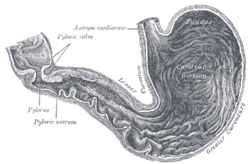Pylorus
| Pylorus | |
|---|---|
 Inside of the stomach (pylorus labeled at center left) | |
| Details | |
| Identifiers | |
| Latin | pylorus |
| MeSH | D011708 |
| TA98 | A05.5.01.017 |
| TA2 | 2930 |
| FMA | 14581 |
| Anatomical terminology | |
The pylorus (/paɪˈlɔːrəs/ or /pɪˈloʊrəs/) pyloric region or pyloric part connects the stomach to the duodenum. The pylorus is considered as having two parts, the pyloric antrum (opening to the body of the stomach) and the pyloric canal (opening to the duodenum). The pyloric canal ends as the pyloric orifice, which marks the junction between the stomach and the duodenum. The orifice is surrounded by a sphincter, a band of muscle, called the pyloric sphincter. The word pylorus comes from Greek πυλωρός, via Latin. The word pylorus in Greek means "gatekeeper", related to "gate" (Greek: pyle) and is thus linguistically related to the word "pylon".[1]
Structure
The pylorus is the furthest part of the stomach that connects to the duodenum. It is divided into two parts, the antrum, which connects to the body of the stomach, and the pyloric canal, which connects to the duodenum.[2]
Antrum
The antrum also called the gastric antrum or the pyloric antrum is the initial portion of the pyloric region. It is near the bottom of the stomach, proximal to the pyloric sphincter, which separates the stomach and the duodenum. It may temporarily become partially or completely shut off from the remainder of the stomach during
Canal
The pyloric canal (
Sphincter
The pyloric sphincter, or
Histology

Under
The pylorus also contains scattered
Function
The pylorus is one component of the
Clinical significance
In such conditions as stomach cancer, tumours may partly block the pyloric canal. A special tube can be implanted surgically to connect the stomach to the duodenum so as to facilitate the passage of food from one to the other. The surgery to place this tube is called a gastroduodenostomy.
Stenosis
Pyloric stenosis refers to a pylorus that is narrow. This is due to congenital hypertrophy of the pyloric sphincter. The lumen of the pylorus is narrower, and less food is able to pass through. This problem is often detected in the early weeks of life. When it is present, a newborn baby may projectile vomit after eating, but despite vomiting remain hungry. Pyloric stenosis may be managed by the insertion of a stent, or through surgical cutting of the pyloric sphincter, a pyloromyotomy.[9]
Other
- Pyloric tumors
- Pyloric gland adenoma[10]
Additional images
-
Stomach
-
Dissection showing the stomach and pylorus in a cadaver. The antrum of the pylorus is shown in green.
See also
- Human gastrointestinal tract
- Stomach
- Duodenum
- Digestion
- A Confederacy of Dunces
References
- ^ Harper, Douglas. "Pylorus". Etymology Online. Retrieved 27 March 2014.
- ISBN 978-0-8089-2306-0.
- ^ University of Illinois Medical Center:Health Library Archived 2012-04-26 at the Wayback Machine
- PMID 9634457.
- PMID 26154756.
- ISBN 978-0781764049.
- ^ Cardiac, fundus and pyloric regions of the stomach, Pyloric region. available from: http://histology.leeds.ac.uk/digestive/cardiac_pyloric.php (Last inspected April 16, 2017)
- ISBN 978-0-443-068-508.
- ISBN 9780723433972.)
{{cite book}}: CS1 maint: multiple names: authors list (link - PMID 18830123.
External links
- "Pylorus", Stedman's Online Medical Dictionary at Lippincott Williams and Wilkins
- Anatomy photo:37:06-0105 at the SUNY Downstate Medical Center - "Abdominal Cavity: The Stomach"
- Anatomy photo:38:07-0102 at the SUNY Downstate Medical Center - "Stomach, Spleen and Liver: The Pylorus"
- Anatomy image:8150 at the SUNY Downstate Medical Center


